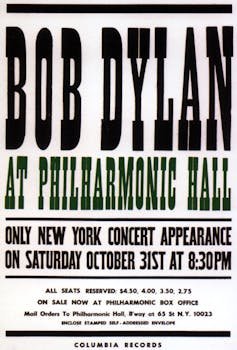Like Amy Winehouse, “Back to Black,” the new biopic about the late British singer, has been no stranger to controversy.
In the case of the film, opinion has been fiercely split about director Sam Taylor-Johnson’s decision to have actress Marisa Abela sing – instead of lip-sync to – Winehouse’s recordings.
Some viewers have lauded Abela’s voice. Others lamented that she sounds “nothing like” Winehouse, or questioned why anyone would even try to imitate such a “unique” voice.
As a music scholar who studies voice and identity, I see two elements stoking this dissonance.
First, Winehouse’s distinctive sound came from her own imitative abilities: She borrowed from a long history of mainly Black women singers.
Second, some viewers seem to want Abela’s voice to be a carbon copy of Winehouse’s. But as I’ve learned in my research, the art of vocal impersonation is less about perfect replication; rather, it’s most successful when performers mimic specific aspects of a singer’s sound that listeners can easily identify.
Imitation and appropriation
Winehouse, who died in 2011 at the age of 27, did not introduce a wholly new sound into the world during her brief career.
The 2006 album “Back to Black,” a collaboration with Mark Ronson, was a consciously retro work. Coming on the heels of Winehouse’s 2003 debut album, “Frank,” it wove together vibrant sounds from soul, neo-soul, funk, jazz, blues and R&B – genres all created by Black musicians and communities.
Yale professor Daphne Brooks has argued that Winehouse’s style appropriated its core elements from Black women singers.
In Winehouse’s husky voice, Brooks heard Sarah Vaughan, Billie Holiday, Lauryn Hill and others.
In the singer’s turbulent personal life, Brooks saw echoes of the blues women of the 1920s and 1930s who suffered through addiction and trauma.
And in Winehouse’s signature look – her “beehive, satin gowns and little black gloves” – Brooks saw the elegant, polished girl groups of the 1950s and 1960s, such as the Shirelles.
Brooks also saw parallels to Sophie Tucker, a white Jewish singer and comedian who rose to fame in the 1920s and who, like Winehouse, made a career borrowing from the performance style of Black singers.
Winehouse didn’t hide the fact that she was paying homage to music and musicians she admired. She even alluded to the difficult cultural tensions her work evoked, telling Hot Press in 2007 that she was interested in “old Motown, The Shangri-Las, Ella Fitzgerald, Dinah Washington, Ray Charles.”
Nonetheless, her critics were blunt about the appropriation in the album “Back to Black,” with The New Yorker’s Sasha Frere-Jones comparing Winehouse’s singing to “some sort of blackface.”
Frere-Jones wondered whether the title, “Back to Black,” was “meant to be literal.” Abela has complicated the equation with her extra layer of imitation: her Winehouse voice on top of Winehouse’s own retro sound.
Capturing a singer’s ‘essence’
The portrayal of a lost and treasured performer is tricky in other ways, too.
Actors are expected to live up to the memories fans cling to. Lip-syncing to the voice of the late celebrity, as Naomi Ackie did in the Whitney Houston movie “I Wanna Dance With Somebody,” can skirt the issue altogether. Occasionally, like Rami Malek’s portrayal of Freddie Mercury in “Bohemian Rhapsody,” actors lip-sync to a fusion of their own voice with that of the singer they’re playing.
But directors have some actors do their own vocal impersonating. Renée Zellweger sang as Judy Garland in “Judy,” Austin Butler sang Elvis’ earlier tracks himself in “Elvis.” Like them, Marisa Abela worked closely with a vocal coach.
Coaches reject the implication that actors are doing cheap impressions or impersonations.
Eric Vetro, who worked with Timothée Chalamet for the upcoming Bob Dylan biopic “A Complete Unknown,” told Entertainment Weekly that Chalamet is “taking on all the characteristics of Dylan’s voice and his mannerisms and his speech patterns, and bringing that into the music – so that when you hear Timothée do the music, what you’re really getting is the essence of Bob Dylan.”
Likewise, Anne-Marie Speed, who coached Abela, told Rolling Stone, “You want [the vocal performance] to be very close, but not an impression.”

Gotham/GC Images via Getty Images
Impressionism, not replication
Actors who successfully play dead singers are really engaging in the art of impersonation, akin to the hordes of Elvis impersonators in Las Vegas. Audiences know they’re not watching the real person. But they do want actors to make a nod to the vocal style, mannerisms and aura of the artist.
Ten years ago, I conducted research with voice scientist Ron Scherer to find out what was going on when one singer tried to sound like another.
I interviewed and recorded Canadian singer Véronic DiCaire before a performance of her Vegas impersonation show “50 Voices.” In her impressive repertoire, she covered a range of singers: Adele, Whitney Houston and even Amy Winehouse.
When embodying Tina Turner, DiCaire told me that she needed very high heels to imitate Turner’s posture. When impersonating other singers, she adjusted the part of her vocal tract where she felt vibrations. For Celine Dion, she explained how she initially wanted to locate the voice in her nose. But her teacher also pointed out that Dion “sings with this long neck.” So her impersonation involved a mix of adjustments in posture and vocal technique.
Using the recordings I’d made, Scherer and I compared spectrographic images – depictions of a sound’s acoustic structure in graph form – of DiCaire’s own voice with her impersonations. Then we compared her impersonations with spectrographic images of the original artists.
We found that DiCaire was not producing exact replicas of the original voices she was covering. But she was hitting specific highlights of their vocal sounds, like the pronunciation of certain vowels or consonants. She’d also adjust the rate of her vibrato – and reshape her vocal tract – to align her timbre more closely with Adele’s or Lady Gaga’s at key points in a song.
One mixed review of the film “Back to Black” critiques it as “a crude highlight reel” of Winehouse’s career, though the author praises Abela’s “fine impression of the late singer.”
But our research hints that singing impersonation is just that: a highlight reel.
In an impressionist painting, the image lies in the artist’s ordering of many details, best viewed from a distance. If you look too closely, it all falls apart.










